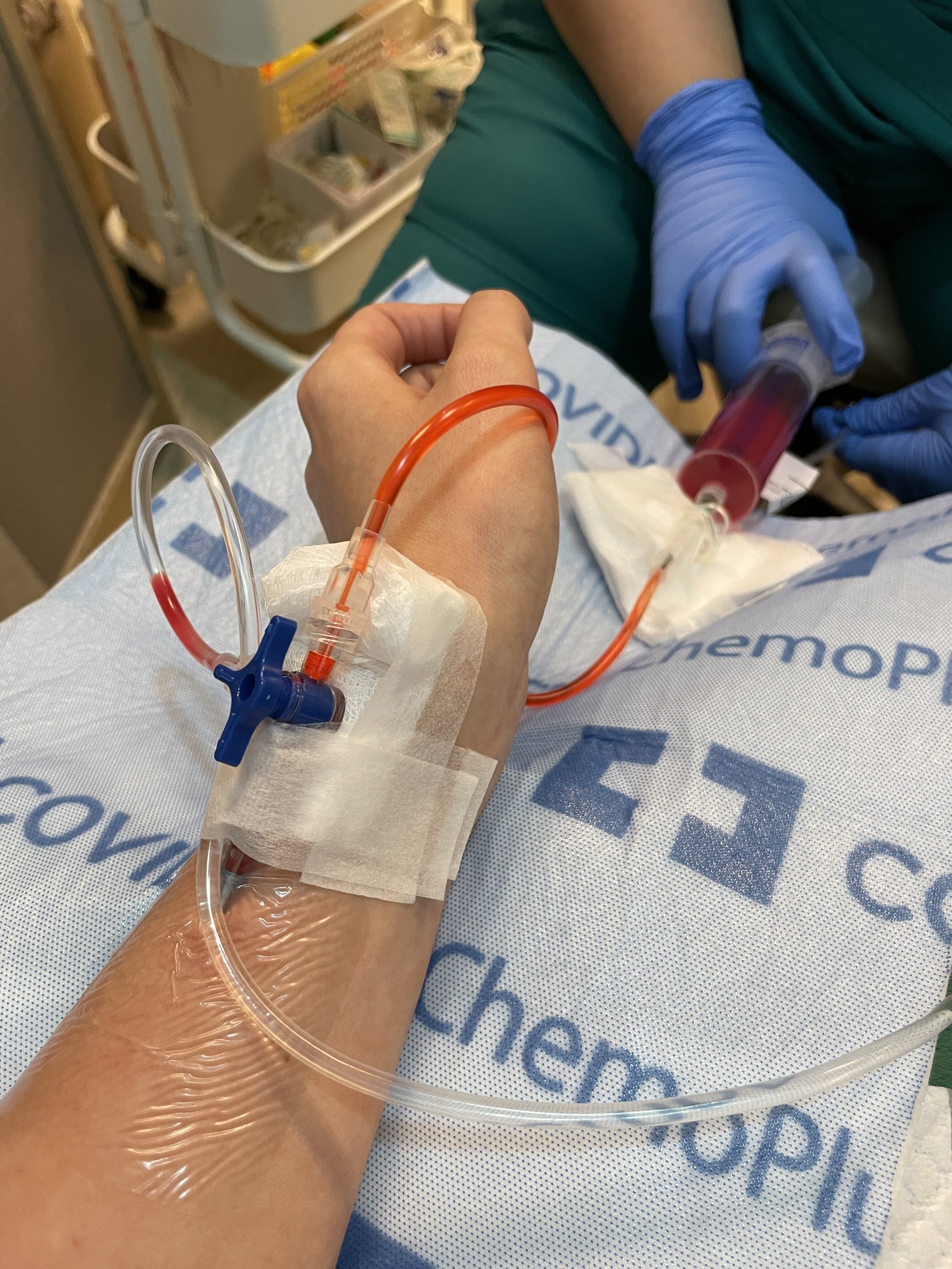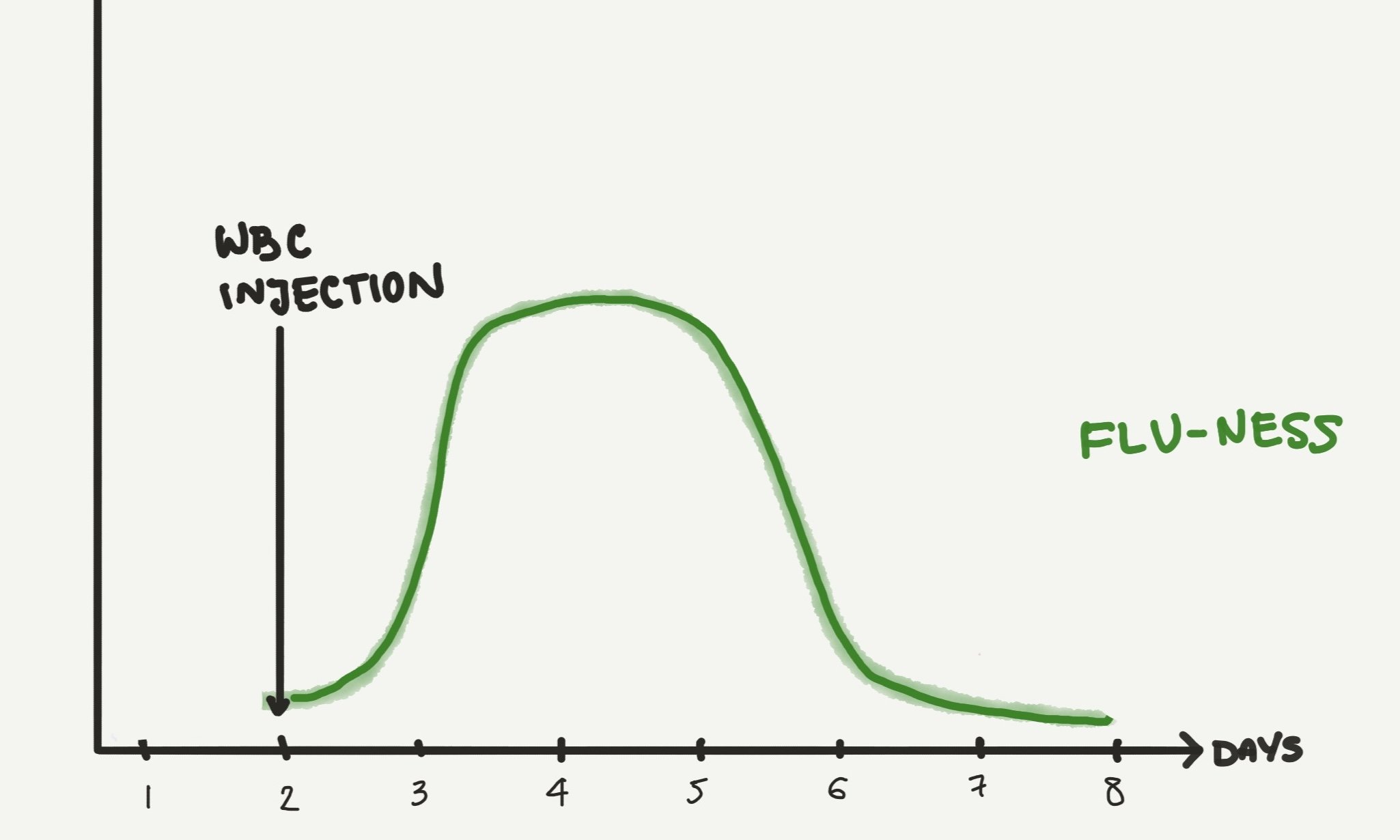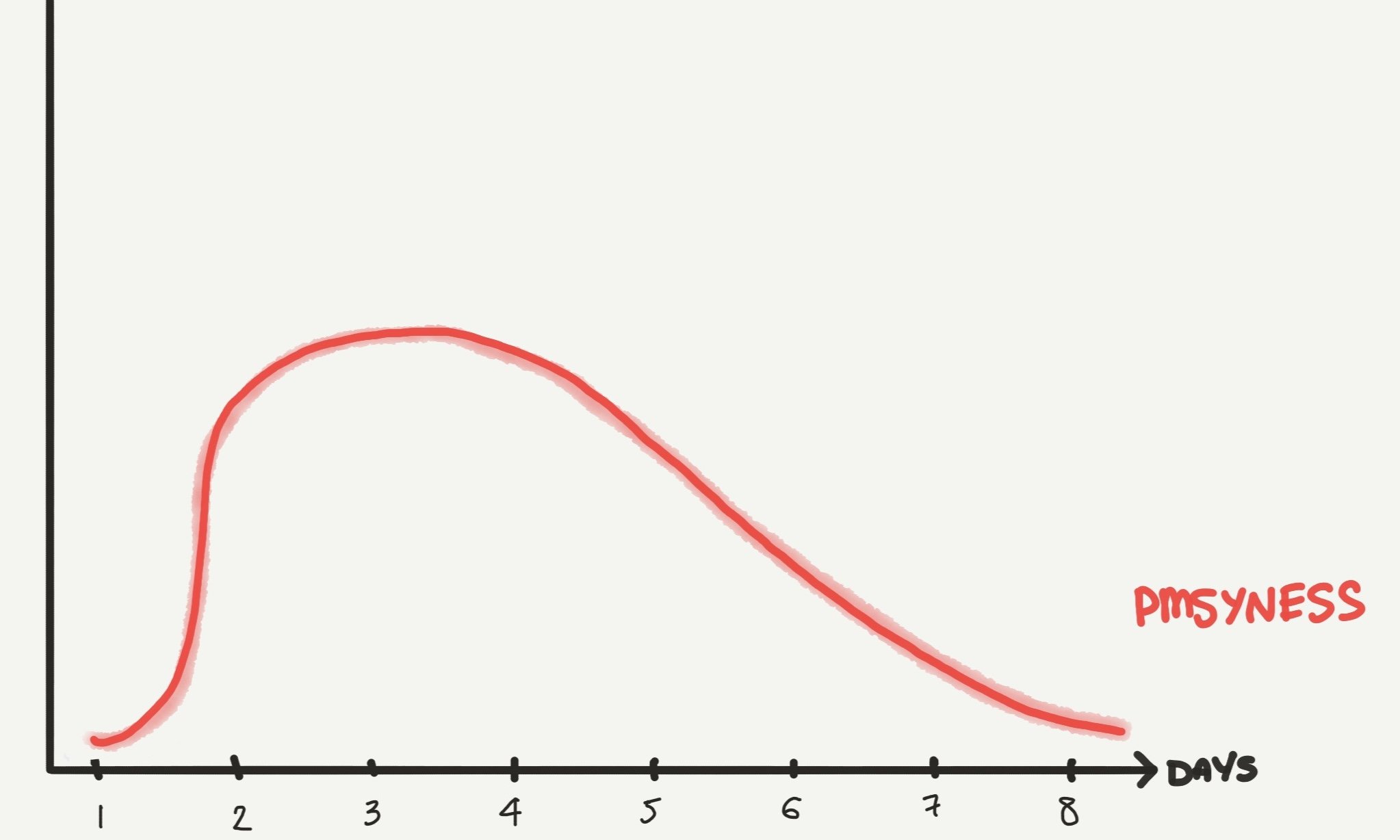Earlier this month I started AC chemo, which is the second drug regimen I’ve been put on in the treatment plan for my breast cancer. Before AC I had 12 rounds of Taxol, Herceptin and Perjeta (you can read more about my chemotherapy plan here and my experience of THP here).
I have a total of four rounds of AC to go through in a dose-dense regiment, i.e. every two weeks. This means my last treatment is planned for January 14 and oh boy, I just cannot wait for that part of my treatment to be over.
AC is known for being one of the more intense chemo drugs. It wreaks havoc on both cancerous and non-cancerous cells alike, causing sometimes really unpleasant side effects. I was nervous about starting this treatment, but I went in without any expectations. I was lucky to have mild side effects from my first chemo and so I was hoping the second one wouldn’t be bad either.
I have now had two rounds of AC and taken two weeks to recover each time, and honestly, it has not been amazingly great. But it was absolutely doable and manageable, because #fuckcancer and however bad I am feeling from the chemo, my cancer is feeling a lot worse!
Today is round 3 (and my penultimate, 15th out of 16 rounds of chemotherapy), I thought I would take the opportunity to share the experience a bit. As always, this is just my personal experience. Everybody’s chemo journey is different, so if you are reading this because you’re preparing for AC, please keep that in mind.
The Infusion
I won’t lie, everything I had heard about AC had me scared going into the infusion centre.
The colour of the “A” in AC, Adriamycin, is bright hot red and looks really scary. The needle has to be placed in the vein by an experienced nurse, the backflow has to be double-checked (i.e. making sure that there is back and forth flow between the tube and the vein), because if any of the drug leaks out into the surrounding tissue, it can be damaging. The nurse also has to wear protective gloves because if her skin comes into contact with the drug, it can cause her harm too. It’s kind of fucked up really - the drug is too toxic to touch, but it’s totally fine to inject into the poor cancer patient’s veins.
I was a bit nervous about the infusion, but thankfully there really was nothing to be scared of.
This is what the process looked like for me:
After arriving at the clinic, the nurse takes my vitals and my weight (chemo has to be prescribed according to body weight and height), and then I go in to see my oncologist. The doctor reviews my vitals and also the results of the blood test I have to come in for one day before each round. I can’t receive the drugs without the oncologist making sure that everything looks ok. We chat a little bit, she asks about side effects I’ve been experiencing, refills my prescriptions if necessary and answers any questions I might have. If everything is ok, she approves my treatment for the day and I go into the infusion room.
Once I choose my seat in the infusion room, I unpack my chemo bag (click here to read what I pack), arrange everything around me so I am comfortable and put on some cozy socks. A nurse will then come check my vitals again and work on setting up the IV.
The first step is cannulation. A needle with a thin plastic tube inside of it is inserted into my vein. After it’s been placed, the needle is removed, so just the thin plastic tube remains inside the vein (this is called a cannula), with some plastic parts attached to it on the surface.
Once the cannula is in the vein, the nurse will connect it with the drip (the bag of medicine that I will be receiving) using a bunch of plastic tubes called lines. Once everything is connected, the drip of saline starts. This is just sodium chloride dissolved in water (i.e. salt). It’s a neutral liquid that doesn’t have any effect on me, apart from hydration. The nurse will also check the backflow and make sure I’m not feeling any pain or discomfort.
I am then given my pre-medication to prevent sickness and allergic reactions. One of the pre-meds is a steroid given intravenously called dexamethasone. It has a really interesting side effect as it goes in - it makes my lady parts tingle, so at least there’s that. That, and the fact it prevents me from getting sick, are the only upsides to steroids though. They also cause my face to puff up for at least a week, make me feel really swollen and fat, and cause a lot of bad mood swings.
After the pre-meds, the nurse prepares the first chemo drug: Adriamycin, the infamous red stuff. It comes in a big plastic syringe and I swear, it really looks terrifying. The nurse pushes the drug into the line herself, without hanging it up as a drip. As it’s going in, we chat and have some laughs. That’s it. I promise it doesn’t feel like anything. It lasts less than 10 minutes.
I take a bunch of photos and videos of the red stuff cause it looks so unreal.
After the Adriamycin is done, the next step is flushing the line with saline. This lasts another 10 minutes.
The next step is the “C” in AC: cyclophosphamide. It’s a small drip bag that is hung up and goes in through the line. It doesn’t look as scary as the Adriamycin, it’s just a clear liquid. It takes about 30-45 minutes to go in. Some people experience some weird sensations during the cyclophosphamide infusion, like a bitter or metallic taste in the mouth, or dizziness or even a headache. I only felt a slight metallic taste during my infusion, so it wasn’t bad at all. Some folks recommend sucking on some hard candies during this part of the treatment to help with these side effects. I brought some hard honey candies and nibbled on them during the infusion, and it was totally fine.
After the second drug is done, the lines are flushed with saline again for a few minutes. Then the nurse checks my vitals again and removes my cannula. I hang out for a few more minutes before gathering my stuff, packing my bag and going home.
Post-Meds
Apart from the post-infusion takeout burgers that have now become tradition on a Friday night in our home, with AC there are also some proper drugs that I need to take for a few days following treatment. The ones below I have to take.
More anti-nausea medicine on Days 2 and 3. This is to prevent nausea and vomiting from the chemo.
More dexamethasone on Days 2 and 3. This is also to prevent nausea and vomiting. More steroids mean a puffy, fat face and PMS-like body and mood swings for another three days. I hate the steroids, but at least they help make me not sick.
Sleeping pills before bed on Days 1, 2, 3 and 4. This is to counteract the effects of the steroids, which otherwise would be keeping me up all night.
An injection on Day 2, about 24 hours after the chemo infusion. This is to help boost the production of white blood cells in my bone marrow. Chemo attacks all rapidly dividing cells, not just cancer cells, and this includes bone marrow. As a result, white blood cell numbers can go down quite drastically during chemo, putting the patient at risk of infections. The side effects from this injection is really bad bone and muscle pain though.
Apart from the “mandatory” meds above, I am also given a small pharmacy of a stash to help deal with any side effects I might be experiencing. These are mostly drugs to deal with fever, muscle pain, upset tummy, stubborn tummy, nausea, vomiting, mouth sores, etc.
Side Effects
I was quite nervous about the side effects of AC. A lot of people are able to tolerate Taxol quite well, and thankfully I was also in this group. But most people have some form of side effects from AC, and they involve being sick and tired quite a lot from what I’ve heard. I tried not to have any expectations, just experience the side effects as they come, be patient and watch them go away. In the end it really was not terrible. At least I still wasn’t sick! Do you think I can make it through sixteen rounds of chemo without puking even once?
For the description below, I am treating Day 1 as the day of the infusion.
After my first cycle of AC, I felt the side effects go on roughly until Day 6. After my second cycle, I was hit the hardest on Day 1, and then the next couple of days were actually a lot milder than after the first one.
Side effects can be grouped together into four individual experiences, all known and experienced by me (and most people) before. Just with chemo, they all happen at the same time and sleep does not make it better. They differ day by day, which I’ve illustrated with some charts below.
The four groups of side effects are below:
Hangover-ness
By hangover-ness, I mean the side effects that feel like an alcohol-induced hangover. This is primarily nausea, i.e. feelings of being sick and possibly also being sick. Regretting certain life decisions is also part of this group of side effects. Like would I have developed cancer if I hadn’t drunk so much vodka during university?
After both cycles so far, the nausea for me was the worst about 4 hours after the infusion.
After the first cycle I went to bed and made myself fall asleep, and then experienced mild nausea for another five days.
After the second cycle, I was hit a lot harder. I felt like I would be sick for the entire evening on Day 1, and I wasn’t able to fall asleep to make it go away. I felt so sick that I actually managed to ruin burgers for myself (like even two weeks later just thinking about a hamburger makes me want to hurl). Luckily I managed to still get through it without actually being sick. After the first day, I still had some mild nausea for a couple of days, but it was totally manageable.
Flu-ness
I think the flu-like side effects of chemo are actually caused by the white blood cell booster. They include feelings of pain all over the body, including muscle, bone and joints. They also include a bit of a fever and just feeling like shit in general. Just like having a proper flu (not just a cold).
For me, these side effects started towards the evening of Day 3, with Day 4 being the worst. They can mostly be managed with paracetamol and staying in bed.
PMS-NESS
Feeling swollen, fat and bloated, feeling emotional and dealing with mood swings - those are the side effects I’ve grouped into feeling PMSy. Truthfully they are probably mostly caused by the steroids.
Fatigue
AC-induced fatigue is something else entirely. I remember waking up in the middle of the night after my first AC infusion and I was just dead tired. I woke up to go to the bathroom, and getting out of bed was actually difficult. Normal tiredness is pretty straightforward - you start out with a certain level of energy and gradually that energy is spent as tiredness increases. Chemo fatigue feels a bit like being hit by a wall. Not hitting a wall - there’s no movement involved on your end. You are just standing there and suddenly a wall of fatigue hits you, sucking out all the energy you had in you. It’s really a very interesting experience (but would not recommend it if you can avoid it).
The really intense chemo fatigue lasts for about three to four days. It doesn’t go away with sleep. I spend the first few days after chemo in bed just resting, slipping in and out of sleep, and upon waking up I just feel the same as before I fell asleep.
By Day 5/6 energy levels improve. I no longer need to spend the day in bed. I can go outside for a bit of a walk or try to do some yoga at home. It’s still a challenge to manage energy throughout the day, but at least the crashing wall of tiredness is gone.
Other side effects
AC also carries some other side effects that are not described by my analysis above. There is hair loss, which is usually complete, including all body hair, eyelashes and eyebrows. Most people lose their hair around the time of the second treatment, but apparently there is a variance of a few weeks. I’m four weeks into AC and my transformation into an egg has not been finalised yet (there are still clumps of soft duckling hair left on my head after Taxol, but even they’ve already started falling out).
There is also possible nail damage. Some people experience nails blackening and falling off, for others it’s just nails becoming brittle. In my case, for now, my nails seem to be ok.
There are also GI (gastro-intestinal) side effects which quite frankly range from one extreme side of the spectrum to the other, and they are pretty much ongoing all the time. It’s manageable, just really annoying. Some people will also be sick (i.e. vomiting) after the infusion and for the first couple of days afterwards. It’s really important to take anti-nausea drugs to try avoid it and hydrate throughout the first five days following the infusion to help with recovery.
There are also other side effects that are less common for the majority of people receiving AC. I had a lot of eye trouble while on Taxol, and unfortunately that trend seems to be continuing now on AC as well. I’m also experiencing slight headaches, which of course make me think that my cancer has spread to my brain.
There are also long-term effects, which happen rarely, but can happen: developing cardiac problems and developing different types of cancer.
All of the above being said, it makes me a bit sad that the treatment for this disease is so very very tough. Modern medicine is amazing, and I am grateful every single day that I am lucky enough to live in these times, where my type of cancer is considered a treatable and curable disease. Part of me just sometimes really wonders, what will it be like a hundred years from now? Or even twenty years? Will I ever be able to witness treatment that doesn’t put people into bed for such a long time, and makes them so much worse before they can get better?
Anyways. I’m off to pack my chemo bag and head over to the cancer centre for today. Fingers crossed that my side effects follow the patterns from the past two cycles, and that I won’t have to go through anything worse than what I’m already expecting!






